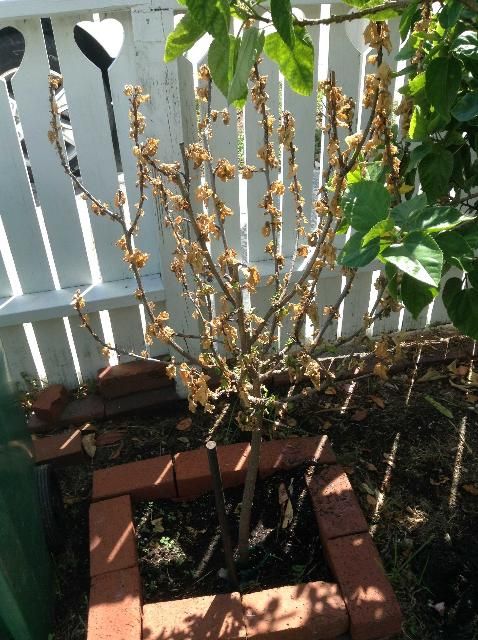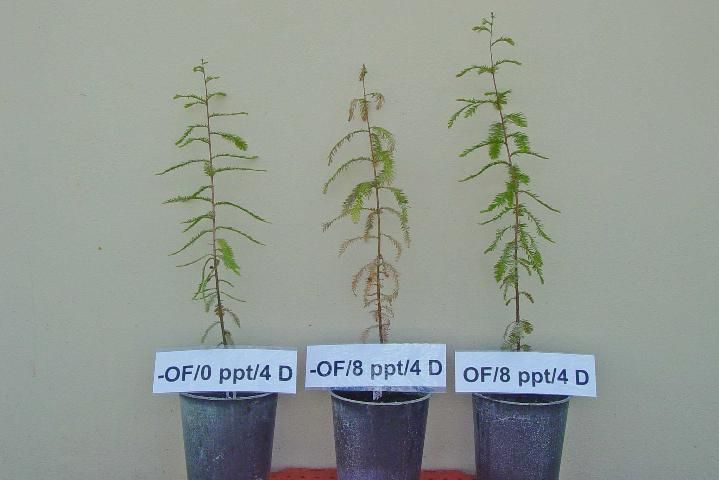Anthropogenic activities can induce climate change and global sea-level rise (Yin et al. 2009). The sea-level rise rate has been accelerating, particularly since the 19th century (Church and White 2011). The rate of global sea-level rise has been approximately 80% greater than the estimates from the United Nations' Intergovernmental Panel on Climate Change (IPCC) Third Assessment Report (Florida Oceans and Coastal Council 2010). Sea-level rise threatens the survival and growth of coastal vegetation in Florida (Garner et al. 2015), many derived from oxygen deficiency and salinity stress on the plant roots. Institute of Food and Agricultural Sciences (IFAS) Extension agents and specialists often get emails and phone calls about dealing with sea-level rise. This article is written for county Extension faculty, homeowners, environmentalists, and students interested in ensuring plant survival and facilitating the growth of coastal vegetation threatened by oxygen deficiency and salinity stresses.
What visible symptoms do plants affected by sea-level rise exhibit?
Plant leaves are susceptible to saltwater stress. Leaves wilt and die when a plant is severely stressed by elevated salinity conditions. Figure 1 shows the effects of high salinity stress on a garden-grown hibiscus plant in Key West.

Credit: Kim Gabel, UF/IFAS
Why does sea-level rise cause plants to die in coastal areas?
Plants grown in lowland coastal areas face two stresses when the sea level rises: excess water (low oxygen) and excess salt (high salinity). Air in the soil is replaced by saline water. The soil becomes hypoxic, meaning that not enough oxygen reaches the plant roots, and the plant is unable to support the aerobic respiration of the roots. The plants cannot synthesize the amount of chemical energy, ATP (adenosine triphosphate), needed to protect plants from salinity. Plants suffering from flooding produce only 5% ATP via anaerobic respiration compared to plants undergoing aerobic respiration without flooding. Because of this limited ATP biosynthesis, the saline water stress reduces water and nutrient uptake, causing leaves to wilt and die (Liu and Li et al. 2012) (Figure 2).
![Figure 2 Figure 2. Bald cypress [Taxodium distichum (L.) Rich.] stressed by different levels of flooding: 0, 50%, and 100% of roots submerged in water containing 8 parts per thousand (PPT) of sodium chloride (NaCl) for four weeks. Most plants died after 100% of roots was submerged while the other two treatments, with 0 or 50% roots submerged, had 100% survival. Row A: 100% roots were submerged; Row B: 50% roots submerged; Row C: no roots submerged.](/image/HS1280/Ds2xqc4s87/D8lyw5nvha/D8lyw5nvha-2048.webp)
Credit: Guodong Liu, UF/IFAS
How can we aid the survival and growth of salinity-stressed plants?
To increase the survival and growth rate of salinity-stressed plants, we can start by mitigating the stress. Coastal plants are grown in lower elevation, flood-prone areas. As sea-level rises, root zones become saturated with saline water. Plants suffer from reduced oxygen bioavailability. One of the easiest methods to circumvent this stress is to enrich soil oxygen bioavailability by oxygen fertilization through fertigation.
There are two kinds of oxygen fertilizers: 1) aqueous formulations of hydrogen peroxide (H2O2) and 2) solid formulations, e.g., calcium peroxide and magnesium peroxide (Liu et al. 2012; Liu et al. 2013; Liu 2014). Hydrogen peroxide is available in a 3% formulation in pharmacies and some groceries.
What are the methods of oxygen fertilization?
Air-saturated water contains 8 ppm dissolved bioavailable oxygen. When flooded, plant roots and microbes readily consume this dissolved oxygen. Oxygen deprivation can be circumvented by applying either an aqueous or solid oxygen fertilizer to the flooded soil. There are two methods of oxygen fertilization:
- Manual fertilization: Irrigate with a diluted solution of hydrogen peroxide prepared by mixing a teaspoon of 3% hydrogen peroxide in one gallon of tap water whenever irrigation is needed or once every other day.
- Fertigation via drip systems: Attach a bottle of 3% hydrogen peroxide to the drip irrigation system (Gil et al. 2009) and keep the ratio at 1:750.
The above chemical strategies work well as short-term solutions (Figure 3). Cultivation strategies can also work, such as planting on raised beds to elevate root systems above salinity-rich soil. However, a biological strategy will be needed for long-term solutions: planting salt-tolerant plants. This approach requires identifying and selecting elite species tolerant to salinity stress. The identification process requires solid scientific research before any suitable selection of species can be made; it is a time-consuming endeavor. To learn more about what to choose for salt-tolerant species, see YourFlorida Guide to Shrubs Selection, Establishment and Maintenance (Gilman and Black 1999).

Credit: Guodong Liu, UF/IFAS
References
Church, J.A. and N.J. White. 2011. Sea-Level Rise from the Late 19th to the Early 21st Century. Surv Geophys 32, 585–602 Accessed on June 10, 2022. https://doi.org/10.1007/s10712-011-9119-1
Florida Oceans and Coastal Council. 2010. "Climate Change and Sea-Level Rise in Florida an Update of the Effects of Climate Change on Florida's Ocean & Coastal Resources." Tallahassee, Florida. Accessed on June 10, 2022. https://floridadep.gov/sites/default/files/Climate%20Change%20and%20Sea-Level%20Rise%20in%20Florida_1.pdf
Garner, K. L., M. Y. Chang, M. T. Fulda, J. A. Berlin, R. E. Freed, M. M. Soo-Hoo, D. L. Revell, M. Ikegami, L. E. Flint, A. L. Flint, and B. E. Kendall. 2015. Impacts of sea level rise and climate change on coastal plant species in the central California coast. Accessed on June 10, 2022. PeerJ, 3, e958. https://doi.org/10.7717/peerj.958
Gil, P.M., R.E. Ferreyra, C.M. Barrera, C.E. Zuniga, and L.R. Gurovich, 2009. "Effects of injecting hydrogen peroxide into heavy clay loam soil on plant water status, net CO2 assimilation, biomass, and vascular anatomy of avocado trees." Chilean J. Agr. Res. 69(1): 97–106.
Gilman, E.F. and R.J. Black. 1999. YourFlorida Guide to Shrubs Selection, Establishment and Maintenance. Gainesville: University of Florida Institute of Food and Agricultural Sciences.
Liu, G. and D.M. Porterfield. 2014. "Oxygen enrichment with magnesium peroxide for minimizing hypoxic stress of flooded corn." J. Plant Nutr. Soil Sci. 177(5): 733–740. Accessed on June 10, 2022. https://onlinelibrary.wiley.com/doi/full/10.1002/jpln.201300424
Liu, G., Y.C. Li, K.W. Migliaccio, T.Olczyk, and A.K. Alva. 2013. "Oxygen amendment on growth and nitrogen use efficiency of flooded Italian basil." Intern. J. Vegetable Sci. 19(3): 217–227. Accessed on June 10, 2022. https://www.tandfonline.com/doi/abs/10.1080/19315260.2012.713451?journalCode=wijv20
Liu, G., D.M. Porterfield, Y.C. Li, W. Klassen. 2012. "Increased oxygen bioavailability improved vigor and germination of aged vegetable seeds." HortScience 47(12): 1714–1721. Accessed on June 10, 2022. https://www.researchgate.net/publication/273259834_Increased_Oxygen_Bioavailability_Improved_Vigor_and_Germination_of_Aged_Vegetable_Seeds
Liu, G., Y.C. Li, A. K. Alva, D. M. "Porterfield and J. Dunlop. 2012. Enhancing nitrogen use efficiency of potato and cereal crops by optimizing temperature, moisture, balanced nutrients and oxygen bioavailability." Journal of Plant Nutrition 35(3): 428–441. Accessed on June 10, 2022. https://agris.fao.org/agris-search/search.do?recordID=US201500059337
Yin, J., M. E. Schlesinger and R. J. Stouffer. 2009. "Model projections of rapid sea-level rise on the northeast coast of the United States." Nature GeoScience 2 (April 2009):262–266. Accessed on June 10, 2022. http://www.nature.com/ngeo/journal/v2/n4/pdf/ngeo462.pdf